

Android. OOTPAPPS.com Android App Development Cheat Sheet. 4 Android Processes, Threads & Services. 3 Android Database Tutorial. 2 Android Fragments Tutorial. 1 Android Tutorial for Beginners [HD 1080p] Slidenerd. Android Application Development Tutorials. Android Bootcamp Series 2012. Home · excilys/androidannotations Wiki. Useful Android Libraries. Useful Android Libraries - Tutorial Copyright © 2011, 2012, 2013 Lars Vogel Useful Android Library Projects This article describes useful Android libraries and example code repositories. 1.
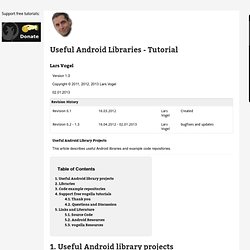
Useful Android library projects The nature of Android as Open Source project makes it easy for others to create useful libraries. 3. The most important source of example code are the API demos of Android. Video Tutorial: Android Application Development - Android UI. Android Recipes and Snippets. I've put together a small collection of Android recipes.
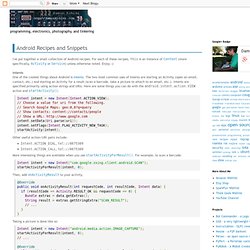
For each of these recipes, this is an instance of Context (more specifically, Activity or Service) unless otherwise noted. Enjoy :) IntentsOne of the coolest things about Android is Intents. The two most common uses of Intents are starting an Activity (open an email, contact, etc.) and starting an Activity for a result (scan a barcode, take a picture to attach to an email, etc.).
Intents are specified primarily using action strings and URIs. Intent intent = new Intent(Intent.ACTION_VIEW);// Choose a value for uri from the following.// Search Google Maps: geo:0,0? Other useful action/URI pairs include:Intent.ACTION_DIAL, interesting things are available when you use startActivityForResult(). Android Development Tutorial. Android Holo themes with backwards compatibility. The Android platform provides a nice feature for app developers called themes.
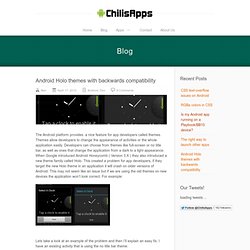
Themes allow developers to change the appearance of activities or the whole application easily. Developers can choose from themes like full-screen or no title bar, as well as ones that change the application from a dark to a light appearance. When Google introduced Android Honeycomb ( Version 3.X ) they also introduced a new theme family called Holo. This created a problem for app developers, if they target the new Holo theme in an application it will crash on older versions of Android.
This may not seem like an issue but if we are using the old themes on new devices the application won’t look correct. Lets take a look at an example of the problem and then I’ll explain an easy fix. I can’t simply change to the new holo theme as follows because it will break compatibilty with 1.X and 2.X phones: Luckily there is an easy solution to this problem! Free Icons Set designed by Brankic1979 - Free psd.
Brankic1979 About icons A set of 350 pixel perfect glyphs icons, perfect for apps, websites or just about anything you can think of.
You may use this icon set for both personal and commercial use, which means this resource can be used in any project without worrying about licensing. But you may NOT distribute our icon set elsewhere without our consent. Some basics. A simple guide to 9-patch for Android UI. While I was working on my first Android app, I found 9-patch (aka 9.png) to be confusing and poorly documented.
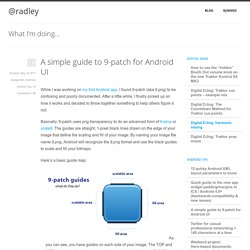
After a little while, I finally picked up on how it works and decided to throw together something to help others figure it out. Basically, 9-patch uses png transparency to do an advanced form of 9-slice or scale9. The guides are straight, 1-pixel black lines drawn on the edge of your image that define the scaling and fill of your image. By naming your image file name.9.png, Android will recognize the 9.png format and use the black guides to scale and fill your bitmaps.
Here’s a basic guide map: As you can see, you have guides on each side of your image. The black guide lines are cut-off/removed from your image – they won’t show in the app. Your guides must be solid black (#000000). Also you should keep in mind that remaining area of the one-pixel outline must be completely transparent. *(updated 1/2012) This is actually a “fix” in the latest dev kit. Design. Using your own SQLite database in Android applications. Most all of the Android examples and tutorials out there assume you want to create and populate your database at runtime and not to use and access an independent, preloaded database with your Android application.
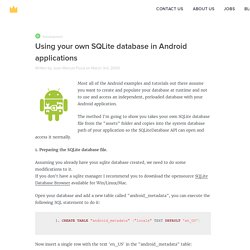
The method I'm going to show you takes your own SQLite database file from the "assets" folder and copies into the system database path of your application so the SQLiteDatabase API can open and access it normally. 1. Preparing the SQLite database file. Assuming you already have your sqlite database created, we need to do some modifications to it. If you don't have a sqlite manager I recommend you to download the opensource SQLite Database Browser available for Win/Linux/Mac. Open your database and add a new table called "android_metadata", you can execute the following SQL statement to do it: CREATE TABLE "android_metadata" ("locale" TEXT DEFAULT 'en_US') Now insert a single row with the text 'en_US' in the "android_metadata" table: